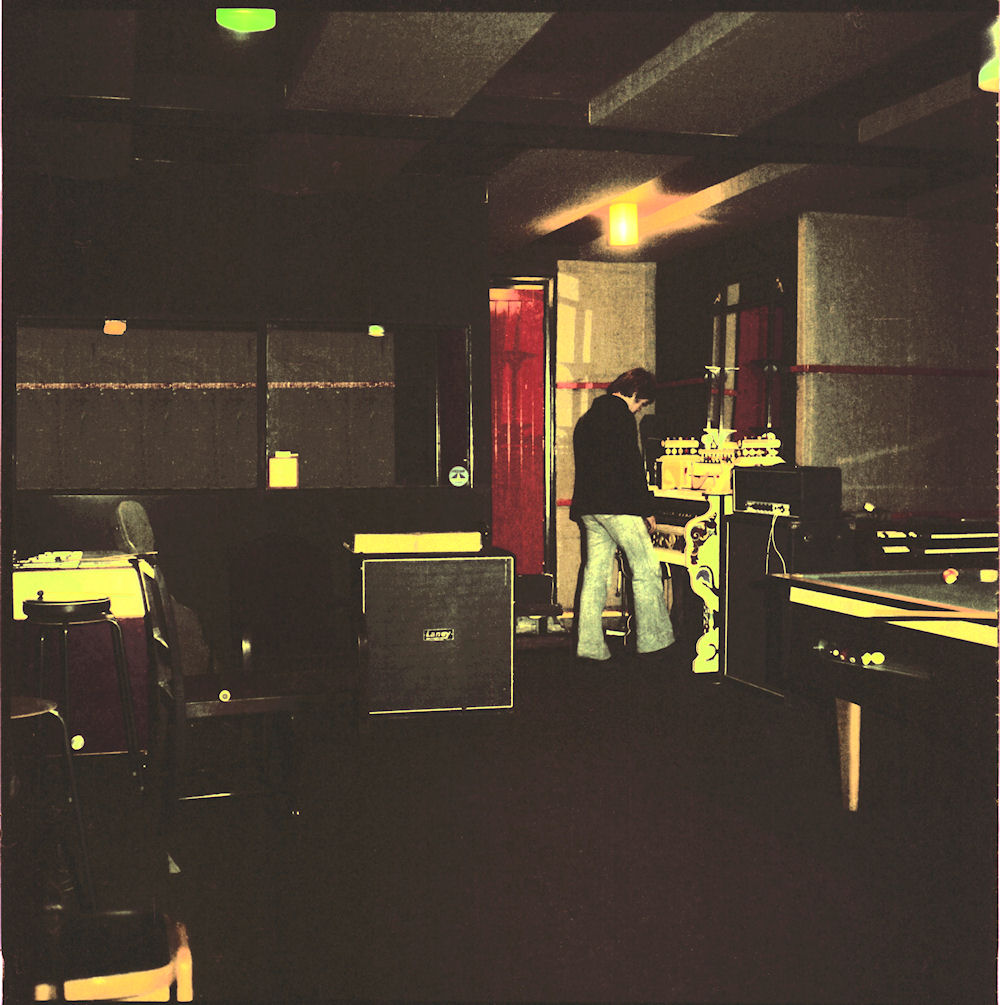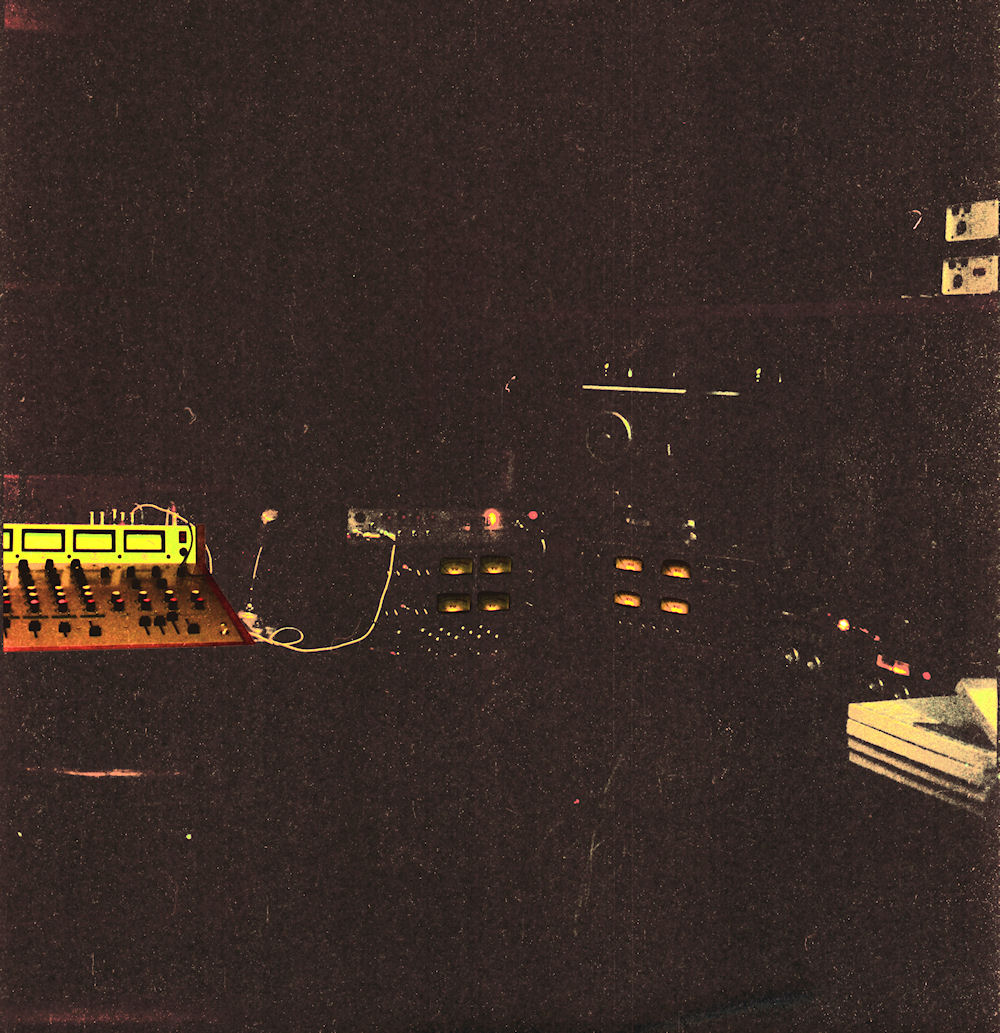CYCLE
Possibly the best band in the world ever!
WARNING: (I may be just a little biased – fourth from the left!)
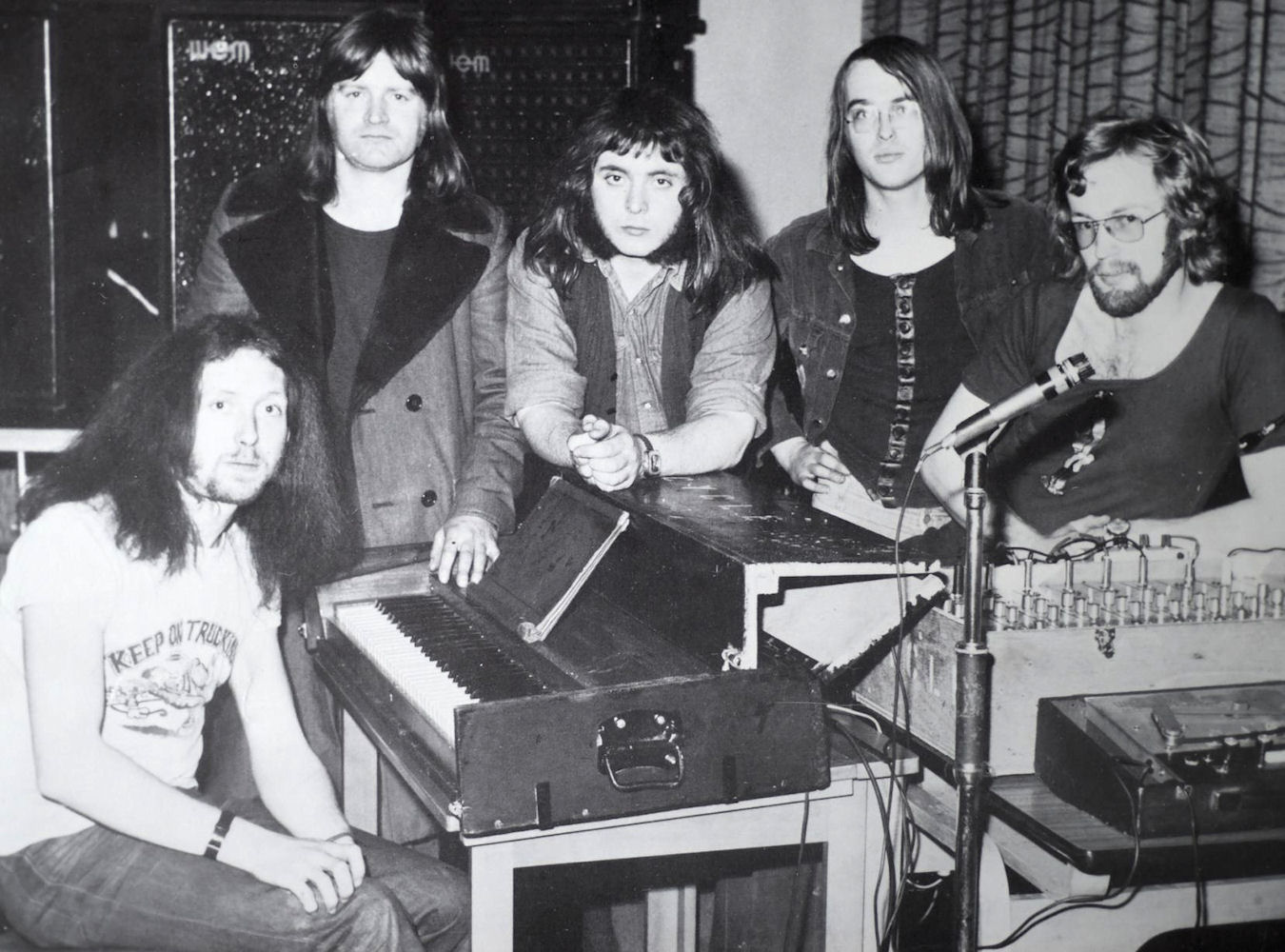
Andy Chisholm, and Malcolm Harker
Shure Unidyne III microphone, Marshall PA mixer, WEM Copicat echo.
Background
Cycle, a North Eastern UK heavy rock band, was formed in 1968 by John Whittingham, lead guitar and vocals, Norman Smith, drums, and Ronnie Patterson, bass. Both as individuals and as members of Cycle they were well established musicians and well known in musical circles in the North East of England. The band's main venues were in the more than 2000 Working Mens' clubs north of the River Tees. Their music was a combination of their own compositions mostly heavy rock with dark themes and lyrics, and the covers - Black Sabbath to the Rolling Stones - necessary to provide the required type of "entertainment" in the venues. The band had a huge number of followers who could be seen regularly in the different clubs, and who followed the band from club to club.
In 1971 the original trio, John, Norman, and Ronnie, recorded an album with six tracks for self promotion. It is known as the "white album" because of the label art work, plain white; as you can see from the images the only way to know which side is which is from the reflections from the wiggles in the grooves; 99 copies of the album were produced.
I knew Cycle from friends at the college where John studied, and went to see them play with Van Der Graaf Generator in 1971. For a local band Cycle had an impressive PA, sound system, and in the Redcar Jazz Club Van Der Graaf Generator used Cycle's PA to play the gig because it was bigger than theirs.
I was also busy in music in the North East at this time. I started playing bass guitar with a band called Bent Beaver in 1968, and later played with Firm Landing. As well as for playing music I had a name as a sound man, and for designing, building and repairing electronics.
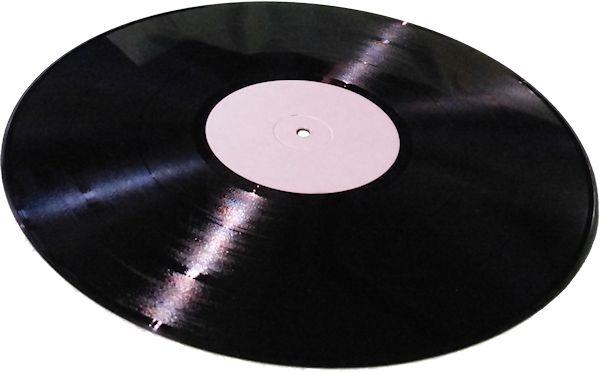
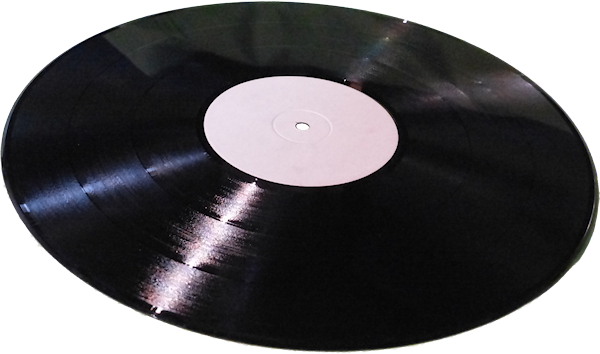
When Cycle's sound man left in 1973 they asked me to join the band and I took over as sound, synths and effects man, and did backing vocals. I made all of the recordings of the band that were produced after the White Album, on the Rise Above release this means tracks 7 to 14, and contributed along with the rest of the band to the music that was written.
Ronnie the bassist left the band a while later and was replaced by Malcolm Harker who had previously played bass in Indian Summer.
The band kept this lineup, shown in the publicity photo at the top of this page, John on guitar, Norman Drums, Malcolm bass, and me as General Dog's Body, until I left to go to college in the summer of 1975. The last two recordings, "Walking Through The Darkness", and "Dawn of a new life", were made in a rush just before I left in Mal's newly kitted out Chisel Hill Mill studio.
Some time later, I don't know exactly when, Mal moved on and was replaced by Mark Bogey on bass. I am not aware of any Cycle recordings that were made after I left.
Music
If you want to hear Cycle's music from the new "Cosmic Clouds" album you could buy it from Rise Above Records.
Alternatively, you could search YouTube using "Cycle Cosmic Clouds". I have found it difficult to find Cycle sometimes, would you believe you get loads of links to bikes?
The tracks on "Cosmic Clouds" are listed here. The first six tracks listed also represents the track listing for the white album:
- 'Rich Man, Poor Man, Pig'
- 'Confusion'
- 'Mr. Future'
- 'Father Of Time'
- 'S.B. Blues'
- 'Earth & Son'
- 'Travelling Man'
- 'Over the Top'
- 'Cosmic Clouds'
- 'In The Beginning'
- 'Father Of Time, Part 2'
- 'Tomorrow's World'
- 'Walking Through The Darkness'
- 'Dawning Of The Last Life'
Johnny Whit — A tribute
Sadly, whatever happens Cycle can never play together again. John passed away on 23rd January 2015. He was undoubtedly the best guitarist that I have ever worked with, he was as good as or better than many of the worlds greats. Other guitarists that I have worked with play well but guitar playing to them always requires an effort. John was a natural, he picked up a guitar and made it sing; almost by mind control it just did what he wanted it to do. His vibrato and sustain were a delight both to see and to hear (press the button below for confirmation). Another tribute to him and to the other band members was that the atmosphere in the band was always relaxed, each member had their role but, we all did anything that was needed to make performances a success. I have to thank John for the opportunity to work with the band and in doing so giving me the best musical experience of my life. A great man, and a Gentleman!
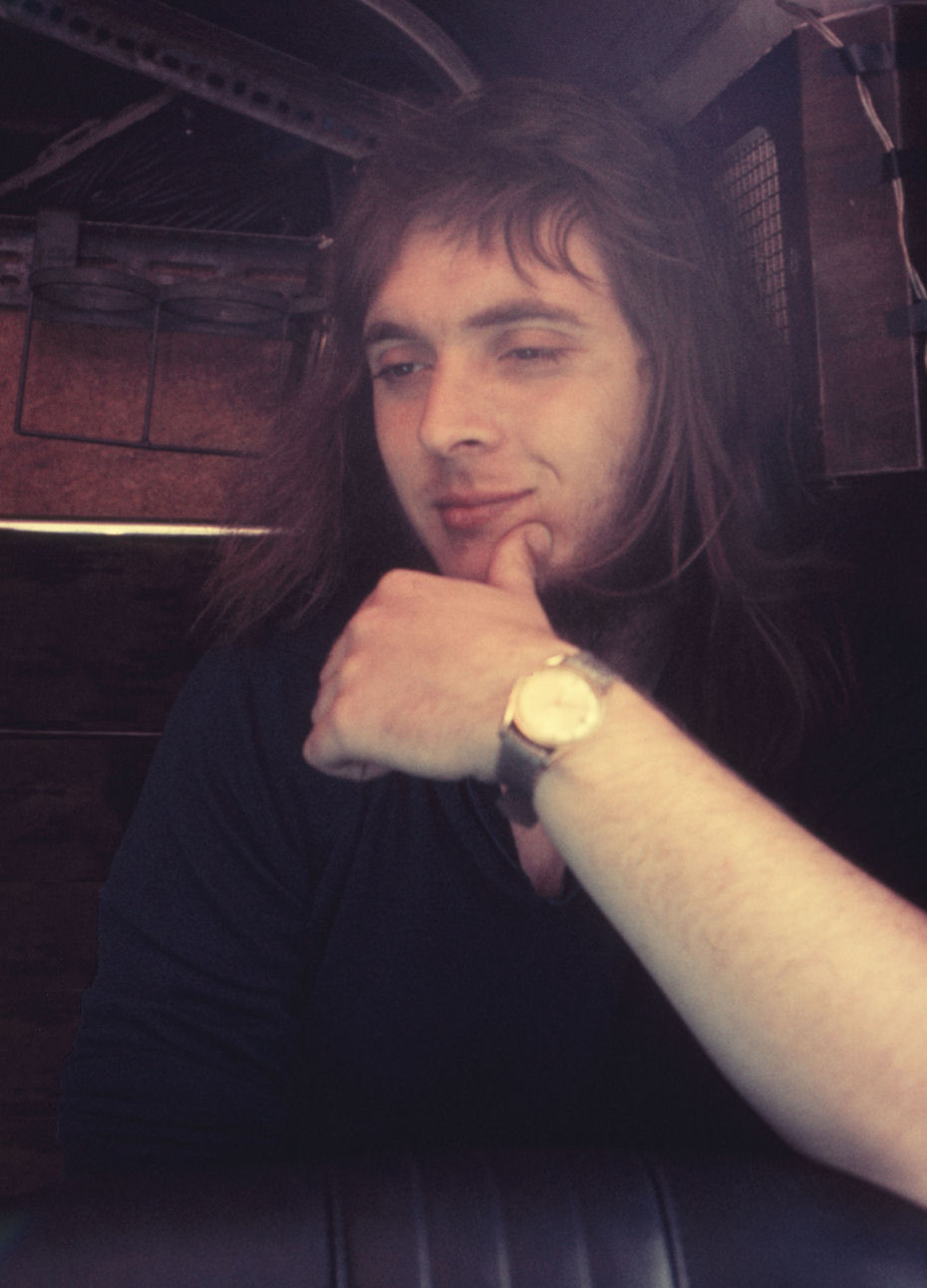
Lightning Bolt, Whernside, and Chisel Hill Mill Studios
Cycle's first album (1971) was recorded in a commercial studio; I wasn't with the band then so I don't know any details. Subsequent recordings were "engineered" by me in our own studios.
By The Way — I digress if I may?
In various places on the Interweb you can read that we "made an album that was never released" after the first album. That is not true; there never was an album, we just recorded numbers. We enjoyed music, we enjoyed performance, and we were interested in making recordings in the same way as we were interested in writing new music. It was all part of the process but, there was never a plan for what was going to happen with what we produced; we were never very good at that.
John was the prime mover for the music writing process although we all contributed in practice sessions to the final output. Mal, the bass player, had sound recording as a hobby (and eventually, with a little help from all our friends, built CHM studio — see below) and he and I drove the technical side of the recording process.
We once piled into the back of the van and went up to London to see a man about our "Demo" and possible deals but, we went to a place in London that had the same name as the place that we should have gone to, missed the appointment, and the rest is history — no deal and in spite of the fact that the band, its musicians, and its music could have been world class, we all went off to do whatever we ended up doing! Ah well!
Back to Studios
At the time, 1973‑1975 the most difficult item to procure for a recording chain was the tape recorder; a Ferrograph or Revox would cost £300‑£600 at a time when £20.00 per week was a fair enough wage for a 20 year old. In the early days we didn’t have access to multi-track recorders but managed to beg and borrow two-track recorders. The recordings were effectively the band performing live in the studio with extra tracks added by using a bit of ingenuity and flip-flopping tracks between the recorders.
The first two of our studios were what today could be called "pop‑up" studios. The third, Chisel Hill Mill, was a real studio built by Mal.
Lightning Bolt Studio was the house where Tricia, my girlfriend, and I lived, 75 Harris Street, in Middlesbrough — long since demolished. It was a two up two down terraced house with electricity downstairs but not upstairs, loo in the back yard, the shower and bath was the kitchen sink, rental £5.00 per week. The front door was dark blue with a silver lightning bolt spray painted on it. The wallpaper was aluminium cooking foil and the heating was whatever we could find to throw on the open fire.
For recording equipment we used the band’s performance gear: instruments, mikes, PA cabling, and we used the PA mixer as the front end for the tape recorders. Nearer to a live recording you could not get. The instruments were in the two downstairs rooms, the PA cables brought the signals upstairs to the front bedroom that was the Control Room.
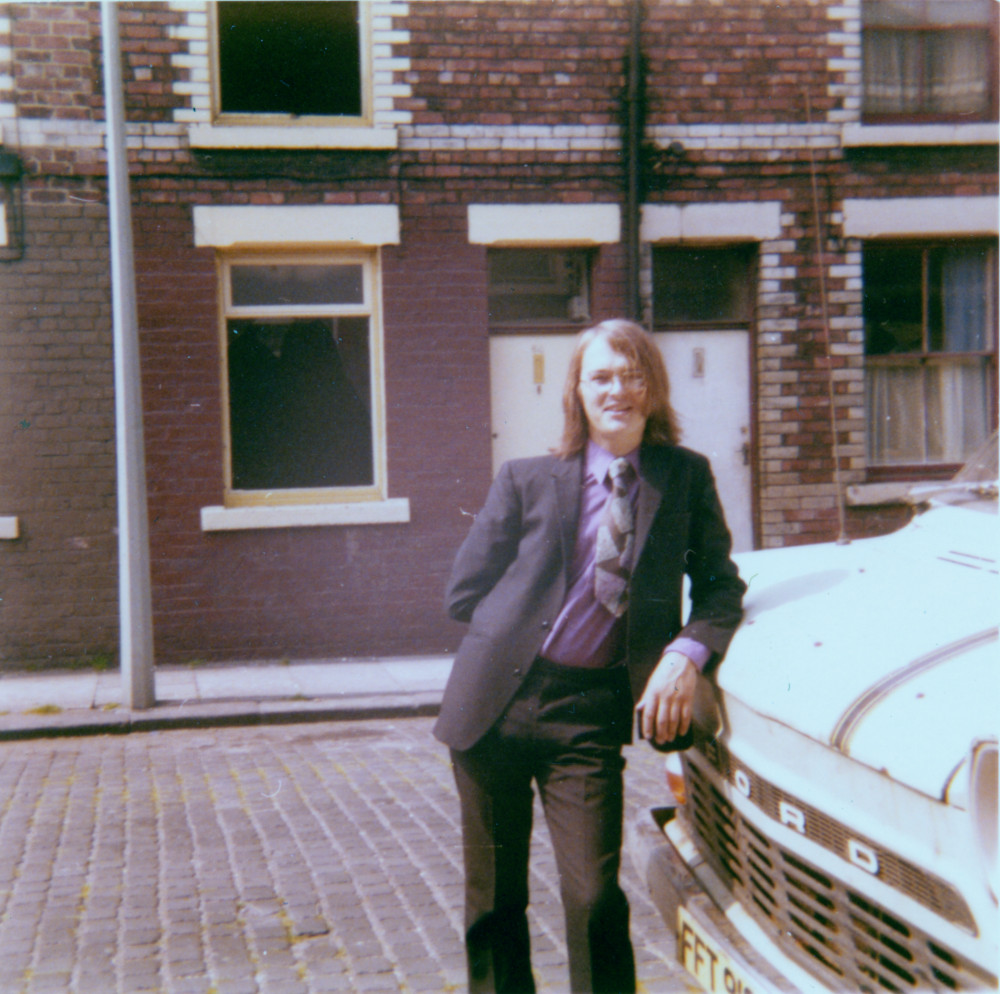
Whernside Studio was a similar situation except that it was my Mum and Dad’s house borrowed for a couple of weeks while they were away on holiday. The studio was the living room at the front of the house, the vocal booth was the downstairs loo (they were posh!!), and the control panel was the dining room table with the PA mixer on top of it. We didn't even need to use upstairs!
The neighbours were sworn to secrecy (they found it fun) and it was years before my Mum and Dad found out!
As the house was clean when they came back from holiday, and the dining table hadn’t been scratched I guess it didn’t matter!
Cycle tracks recorded at Lightning Bolt and Whernside were:
- Travelling Man
- Over The Top
- Cosmic Clouds
- In The Beginning
- Father Of Time Pt.2
- Tomorrow's World
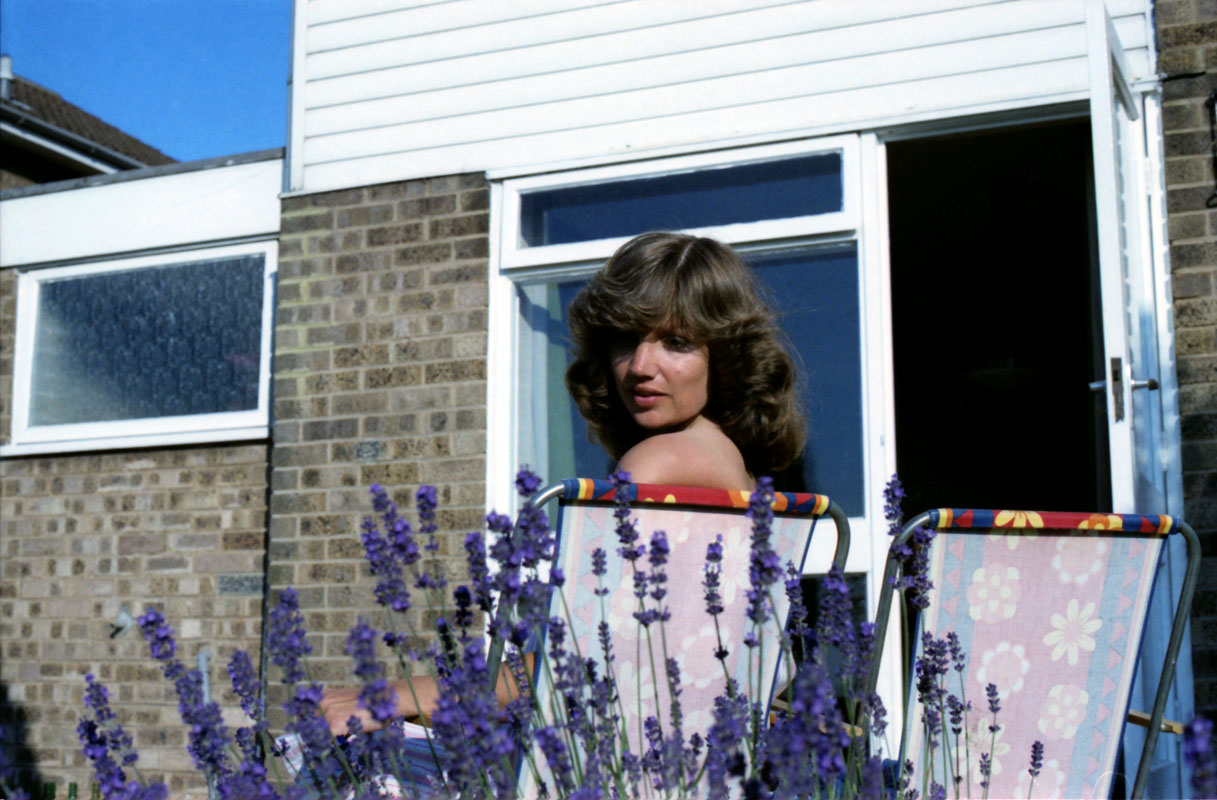
Thus, all of those that are not on the first (1971) album, minus the last two tracks, "Dawn Of A New Life" and "Walking Through The Darkness", that were recorded at CHM.
Again there are no pictures of the inside of the house at the time of the recording. The picture shows a view of the Dining Room, used as the Control Room, from the garden. Nice photo I think. The lady in the picture is (still) about 21.
Chisel Hill Mill, CHM, was a real studio. It was purpose built in a barn in the North York Moors at the house of the bassist Malcolm Harker, see the pictures below of the building of the barn.
The studio was constructed on three isolated concrete floor sections; two became the studio and one was the control room. It had a ton and a half of sand in the roof to provide sound insulation and rockwool on the walls mounted behind hessian for sound absorption. The studio was initially equipped with a four track Teac tape machine, and an ITA, Industrial Tape Applications, 10-4 mixer. The monitors were 15 inch Tannoy Monitor Gold dual concentrics. The mastering machine was a Revox A77HS 15/7.5 i.p.s. (inches per second) 1/4 inch half track stereo tape recorder. The additional electronic systems needed for signal routing, for monitoring, etc. were designed and built my me.
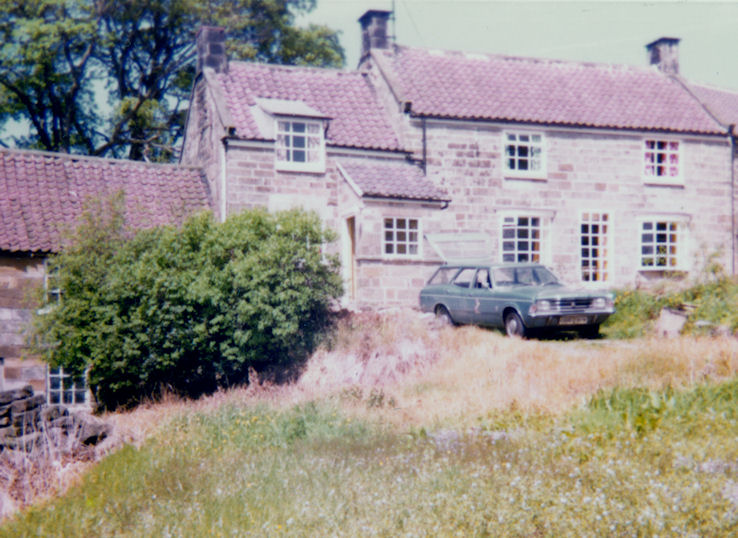
Later the studio was upgraded to eight track. The new equipment included: an eight-track Tascam recorder with dbx noise reduction, a Studer 1/4 inch, 1/2 track, stereo mastering tape, and a Soundcraft Series 800, Model 0818, 18 into 8 mixer.
The picture shows the house, the studio was constructed in a barn to the right. At the end of this section there is a couple of pictures taken at the time of building and a puzzle to see if you can identify the contents of the studio in my really dreadful, underexposed pictures from the time. Even if I managed to borrow a camera I didn't have a flash. Folks have it so easy nowadays.
The Cycle numbers recorded at Chisel Hill Mill were the last two, "Dawn Of A New Life" (misnamed on the Rise Above release), and "Walking Through The Darkness". They were not recorded as "Demo" recordings, what sets them apart is that they were simply the first and only Cycle recordings made at Chisel Hill Mill.
We had just finished the studio and I was getting ready to go to college so these were the only Cycle recordings we had the time/opportunity to make there.
Press the button below to hear a moment of history from years ago that defines the name of the DOANL track.
I still have a tape with first generation copies of both of the Chisel Hill Mill tracks that was made directly from the master. This is where the audio under the button is from.
As a name dropping note, the studio was used by Chris Rea of "Fool (If You Think It's Over)" fame, he used the studio to develop his music and to make demos. The song "Chisel Hill" from the album "Shamrock Diaries" is referring to this beautiful and restful location.
Building the barn
A couple of photos from the building of the studio. Mal and myself helped by Dave Holiday from Firm Landing and ?? If you know who please send me an email to let me know. Mal got a bit cut off in the second picture. Not my fault this time, I wasn't taking it, I am in the picture!!
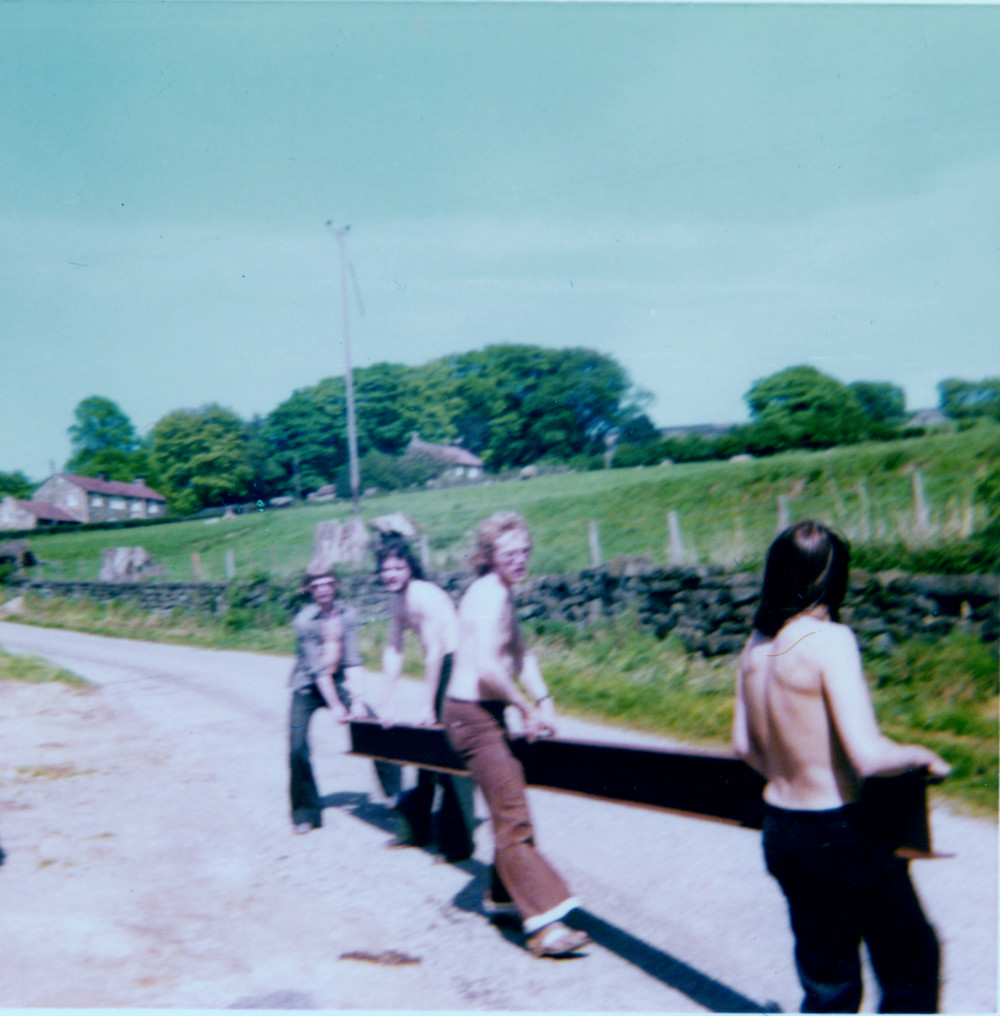
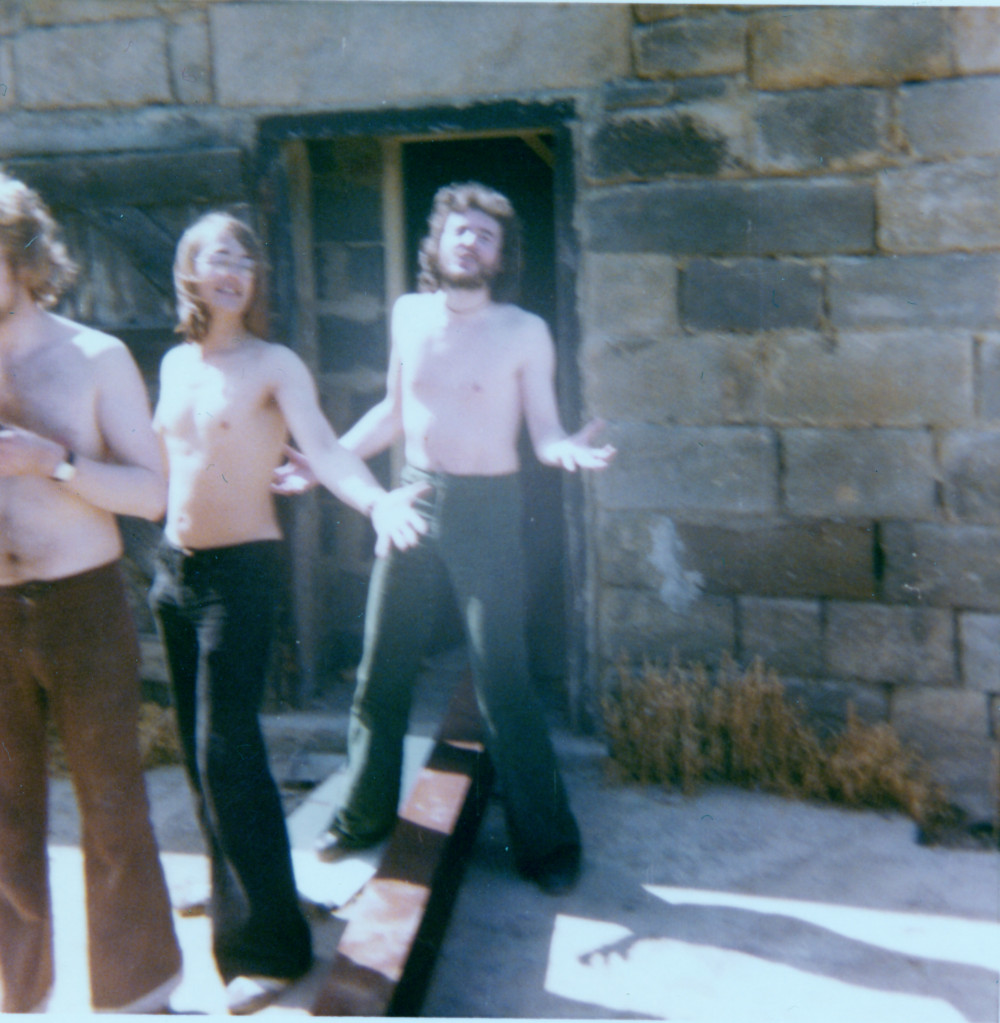
Now it's puzzle time
Can you find the items in the lists in these lousy photos.
Hint: click on the photos, I managed to enhance them a little.
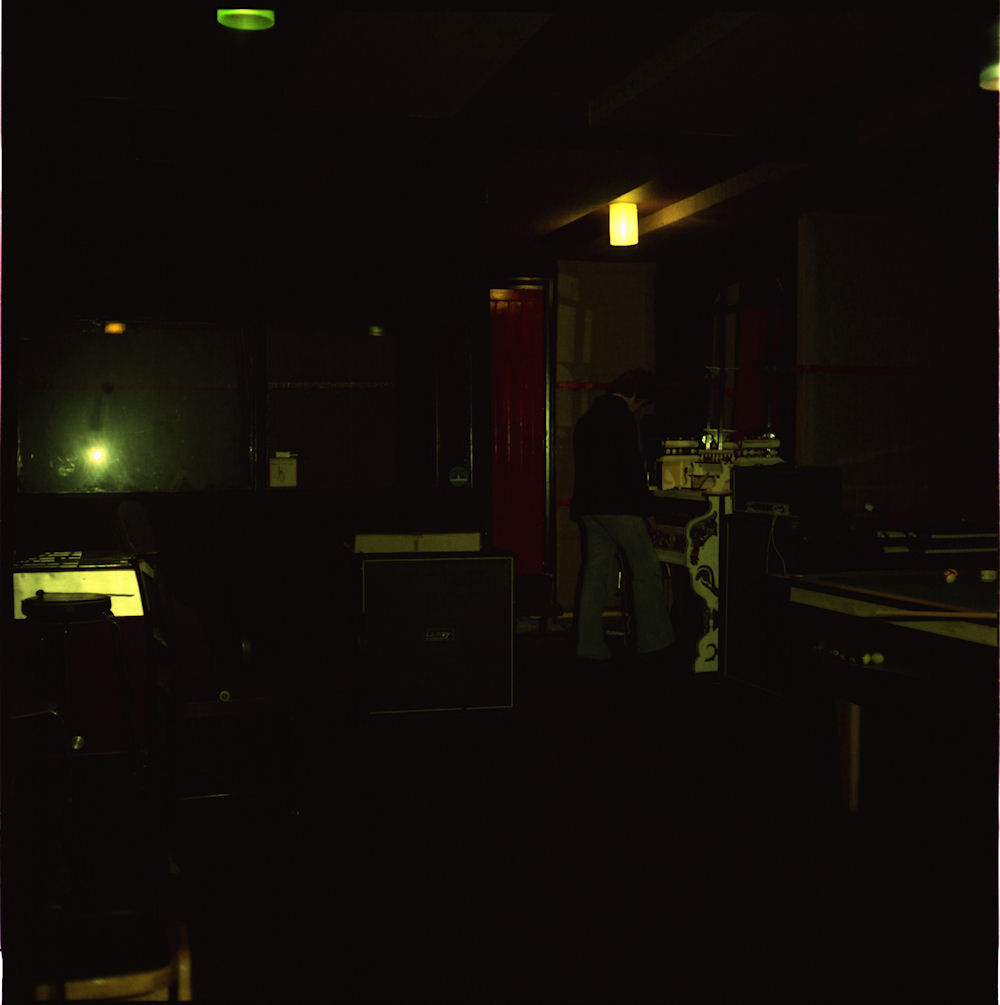
Things to find:
- Vibes
- Drum booth
- *Laney 100 W amp and 4×12s
- Door
- Brother
- Harmonium
- Another *Laney 100 W amp and 4×12s
- Pool table (I won a bottle of whisky on that!)
- Lowrey organ (It was Jim's — I fixed it!)
* Laney amps were "de rigeur" in Cycle. I was the only one with a Marshall but I didn't play guitar in the band!!
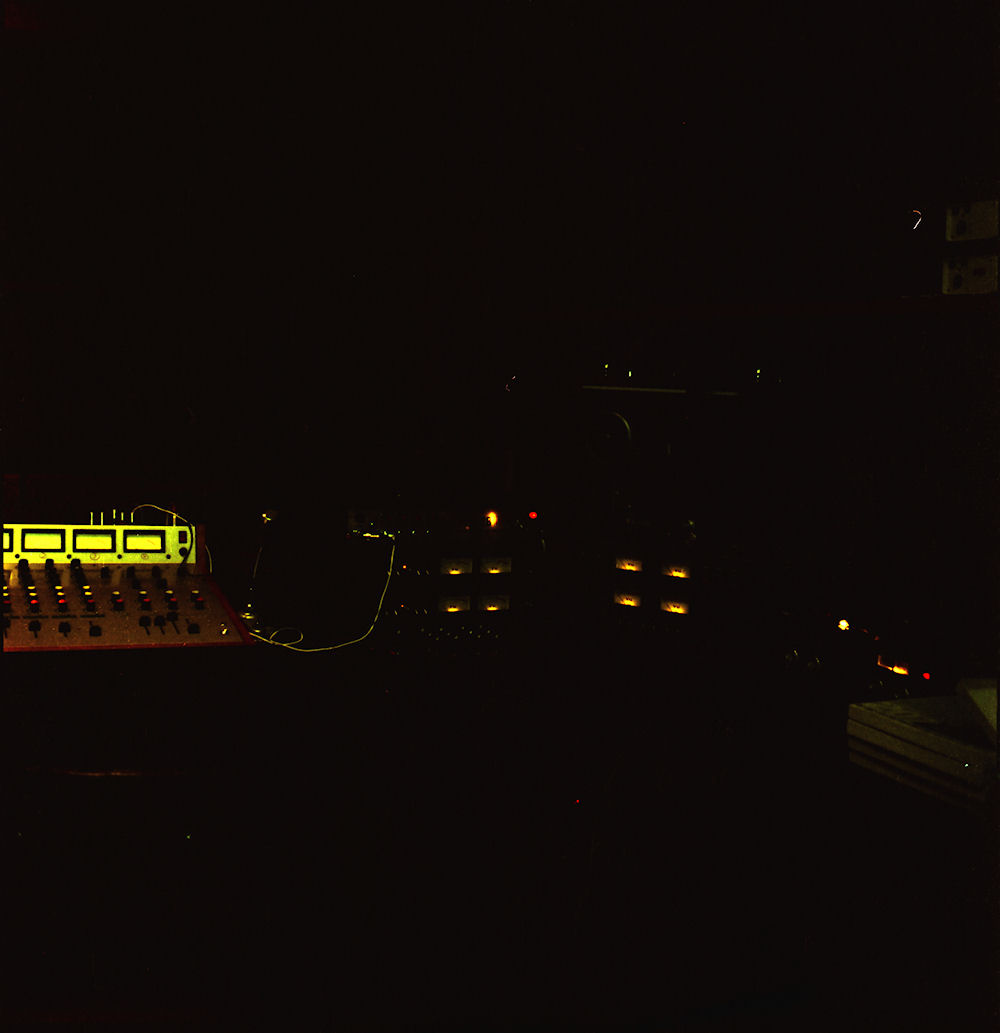
Things to find:
- Industrial Tape Applications 10‑4 mixer
- Talkback mike
- Reverb unit
- Dolby NR system
- Monitoring and routing mixer
- Teac 4‑track tape machine
- Revox A77HS
- Boxes of tape
- Things on the shelf? I don't remember what they were. Condenser mike PSUs maybe?
Not seen are Tannoy Monitors, Quad 405 main amp, home made 30 W headphone amp, other stuff.
Gallery
Just a few "previously unpublished" photos of the guys in the band.
Hint: you can click on the photos but it won't help; this is what they looked like! I couldn't enhance them at all!
Alternatively, you can't improve on perfection!




John (Johnny Whit) Whittingham. The world's greatest undiscovered guitarist;
my honour to have worked with him.
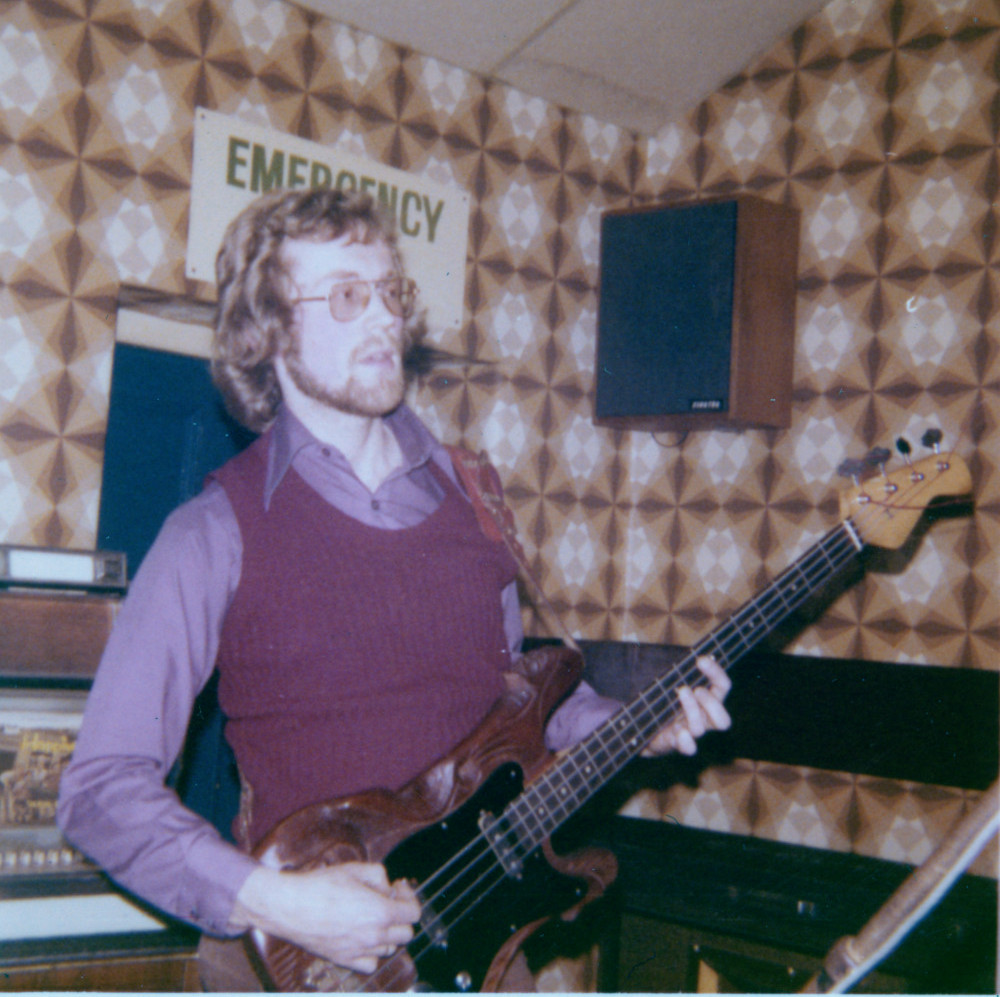
Still plays the same bass
The sign above his head says it all.
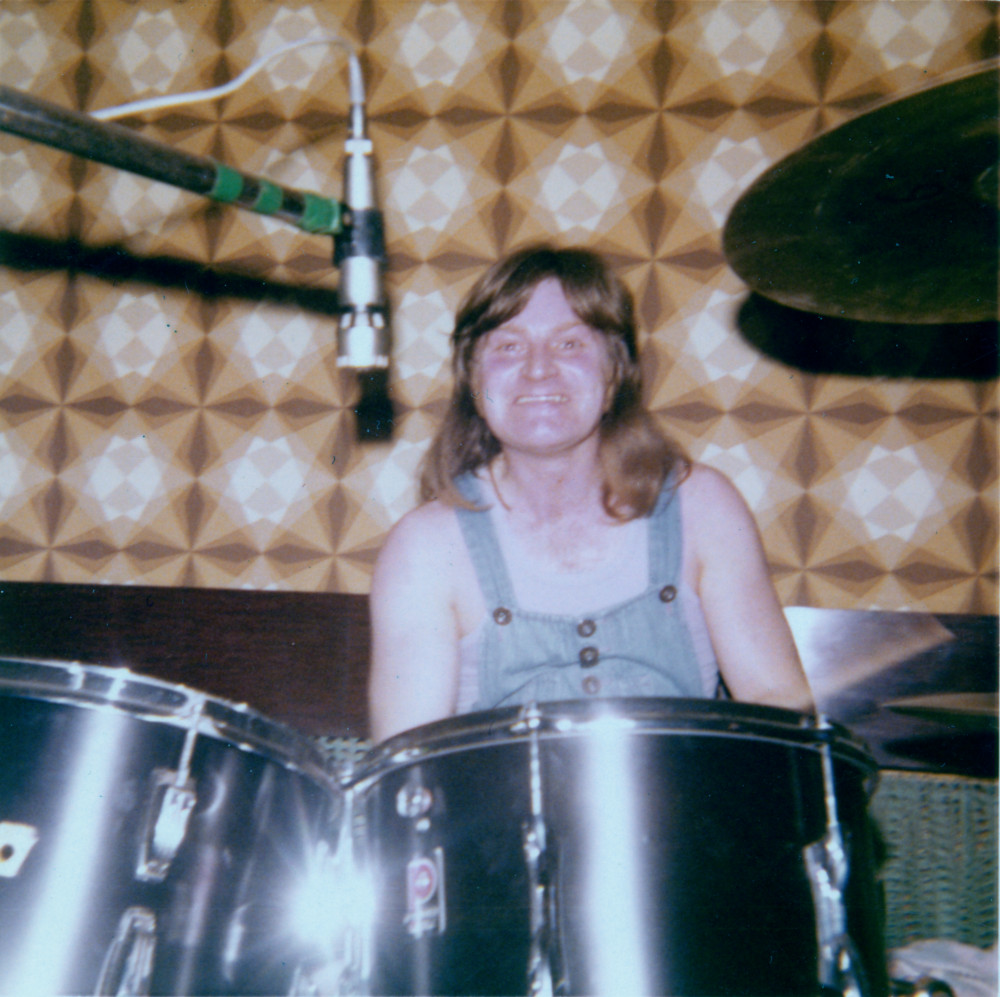
Double drumkit double the drummer; I helped him with his speedstripes you know (see below).
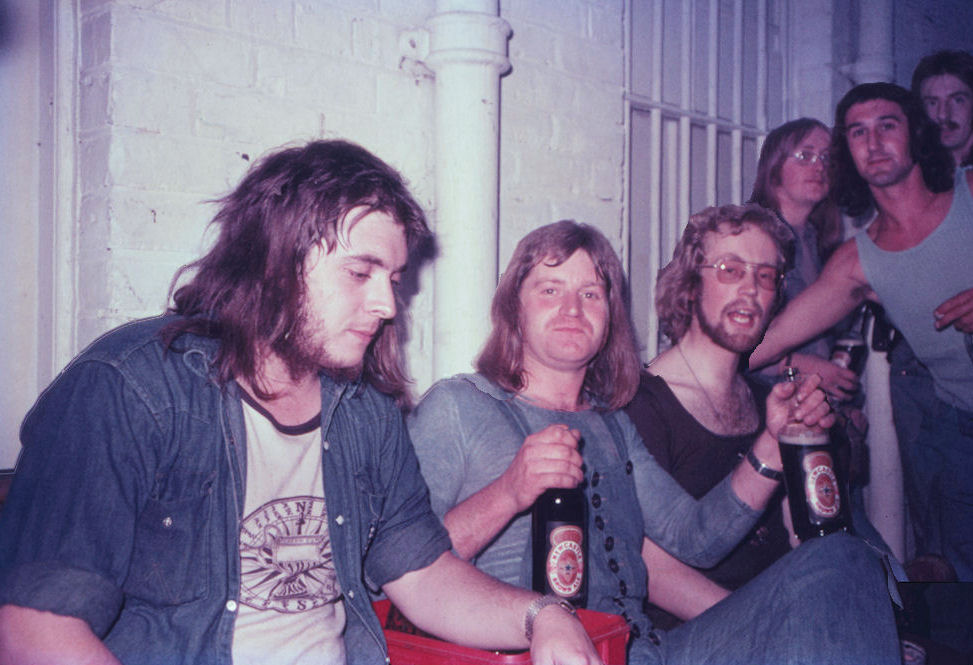
I made this photo by superimposing three others. It was the only way to get them all to (almost) smile at the same time.
Anecdotes
And now, embarrassment in the name of short stories and humour!
Cellar Club Ashington
We played a number of times at the Cellar club, one of my favourites, just a nice place to go to with nice people. It was very small and very dark and there were few if any tables in the club.
We played the first set and got a poor response, no clapping between numbers, and we were, to say the least, disappointed. The manager came over after the set and said, "Really great lads your going down fantastic." We said that we thought differently: no clapping, little response, and he said, "Look around, there are no tables for them to put their drinks on. How can they clap with a beer in their hands?" Sure enough as the evening wore on the audience and the gig were fantastic. We were asked back a number of times.
Speed Stripes
Our group van (shown in the picture outside Lightning Bolt Studio in Harris Street Middlesbrough) was a "sort of light blue", 35 hundred weight, long wheel base, Ford Transit with two rows of seats in the front and a ton and a half of gear in the back.
The band was well known for its ability to support the Northern Breweries almost single handedly and, on the way home from a gig, if someone felt the need for a technicolor yawn we didn’t stop. The routine was to wind down the side window and chuck up down the side of the van. The result was “Speed stripes”.
I was usually the last drop off before Norman drove home, so we would stop and I ran into the house to get buckets of water to slosh down the length of the van to remove the decoration.
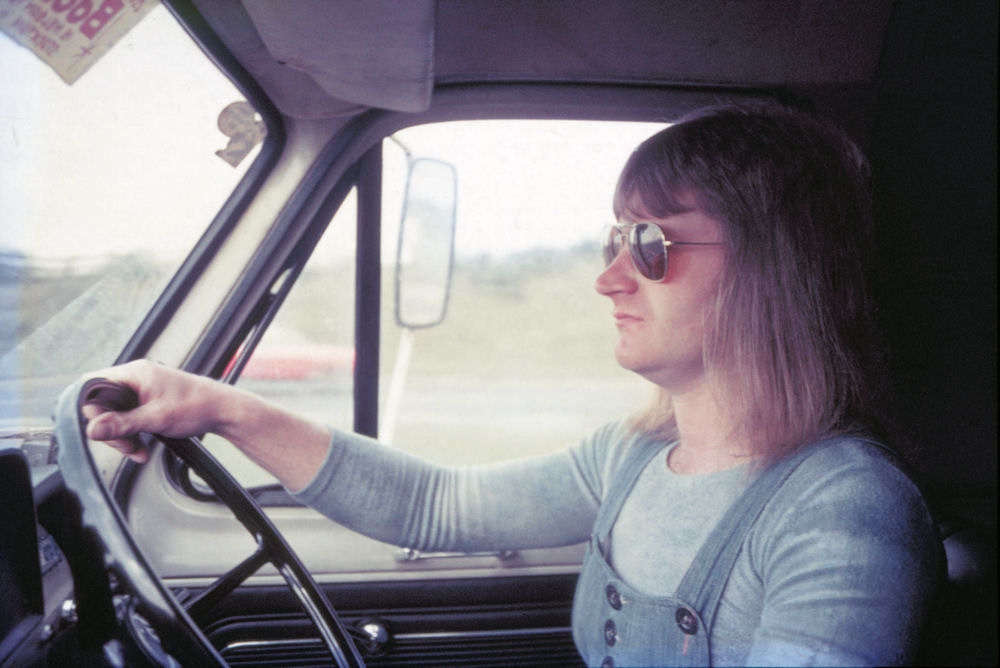
Fooled You!
Another driving related incident. Visibility is always an issue when driving a commercial vehicle like a van. Sometimes, to help you get out of awkward places, you can ask a reliable passenger if all is clear on their side of the van and, given the all clear, you can proceed in safety.
One fine day, good visibility, nothing untoward or generally hazardous about the road or weather, full load of gear and personnel, Norman driving, we approached one of those awkward junctions (for a van driver) where you come up to a main road at an angle. You can see to the right OK but you cannot see what is coming from the left because of the angle of the junction.
Norman couldn't see of course and asked if it was clear. A voice piped up, "Yes! OK!", and Norman pulled out to cross the road.
Immediately, there was a huge squealing brakes and tyres on the road at our left, we stopped suddenly, we were all thrown forward and almost brought all of the gear behind the partition into the front with us, then a lorry passed by in front narrowly missing our bumper. A voice from the back of the van said:
"Fooled you!"
Sheep Whistling
Travelling to gigs with a band you spend hours on the road and travel hundreds of miles each week. One of our number, I won't point the finger, used to enjoy winding up the animals in the fields as we drove by. He discovered that you could make sheep run all about the fields if you whistled loudly. Theory was that they thought there was a sheep dog in the field and reacted even though they couldn't see it.
The other thing he enjoyed was scaring pigs in the fields by shouting "Sausages" at them!
You know who you are!
Tower Of Power
During the '70s electronic gizmos became more and more a thing. Every week on Tomorrow's World Raymond Baxter and his cronies introduced all kinds of new gadgets and solutions to non-problems that the world couldn't do without! So, what's changed? Only the names and the faces I guess.
Anyway, some clever dick thought up a system that cut off power to the stage if the sound level got higher than a given threshold. There was a tower of lights that lit up higher and higher as the sound level increased like a giant decibel meter until it got to the top and the power cut off.
Cycle was playing in a club in Ashington that had installed one of these gizmos and the obvious happened. The sound level increased to the point where it broke the barrier and *bang* the stage power shut off — stage lights went out. We just kept on playing.
Needless to say the powers that be in the club were furious to have been made fools of. The younger club members thought that it was hilarious. The club had spent all that money on the gizmo and it hadn't done its job.
What happened?
One of the primary functions of the sound man — before anyone makes a sound — is to ensure the safety of the band members. Wherever we went the first thing we did was find a "safe" source of power with a verified, good earth. To do this we had testers and very long extension leads so that we could import power to the stage if there were any issues with the stage power at a venue. That night in Ashington the power came courtesy of the ladies toilet!!
Gear
For anyone who is interested a few notes about the gear that we used.
PA System
There were three generations of the PA system. They all used the same amplification, a Hiwatt 6-channel 100 W PA amp, a Hiwatt 4-channel 100 W PA amp, and two H|H 100W slave amps; additionally there was a 100 W Hiwatt slave used to power the monitors. My Marshall 100 W Super Bass amp was a "spare" in case any one of the other amps, PA or Stage, died.
The differences between the PA systems were in the mixer and the speakers.
When I joined the band they used the 4 and 6-channel Hiwatt PA amps as the mixer, 10 channels in total.
Later, when Malcolm Harker joined the band, he brought with him a Marshall mixer that he used for recording. It became the primary mixer for the PA after that.
Signal Sources
On stage, all three musicians had a vocal mike, mikes were used in front of the guitar cabs as a feed for the PA, and Norman's drums had five mikes including Shure Unidyne III, an AKG D1000 (overhead, you can see it above in the picture of Norman), and a Shure Unidyne B. A total of 10 mikes on stage.
In addition I had a vocal mike at the back of the hall, the two WEM Copicat Echo machines (vocal and John's guitar) needed inputs in the PA, and there were various sound generators and synths that needed connections from time to time, and we had well run out of input strips on the mixer.
To reduce the number of stage connections needed, and to provide a connection point for the long cables to and from the stage to the Mixing bay, I designed a 5‑channel Front of House mixer to mix the drum mikes into one channel. It also connected outputs from the mixer to the PA amps, and the monitors, and inputs from vocal and guitar mikes to the mixer. The Front of House mixer was powered over the cables from the Marshall mixer.
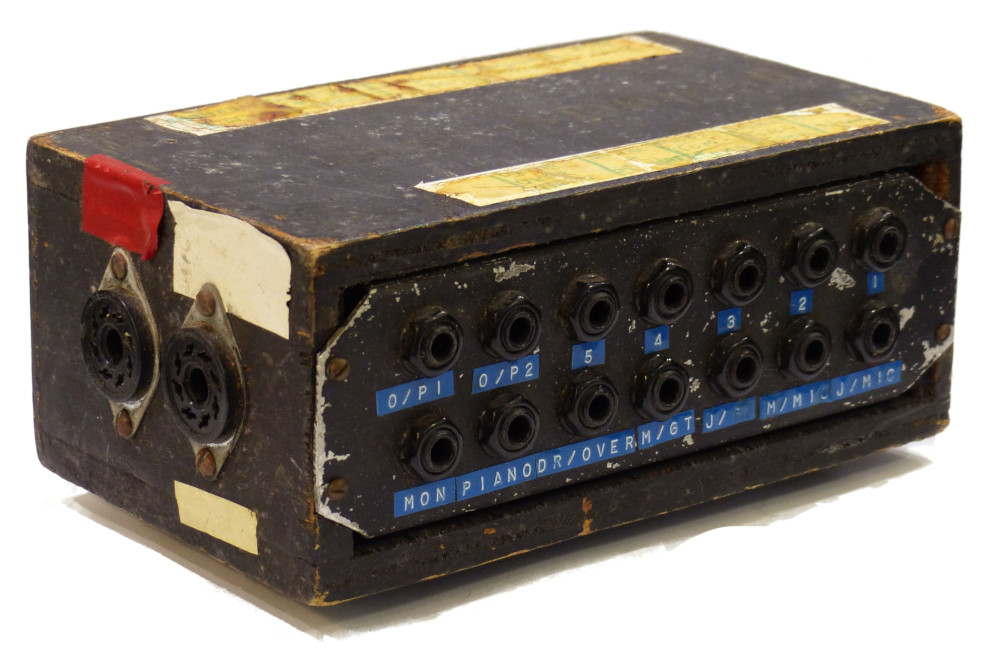
Signal Distribution.
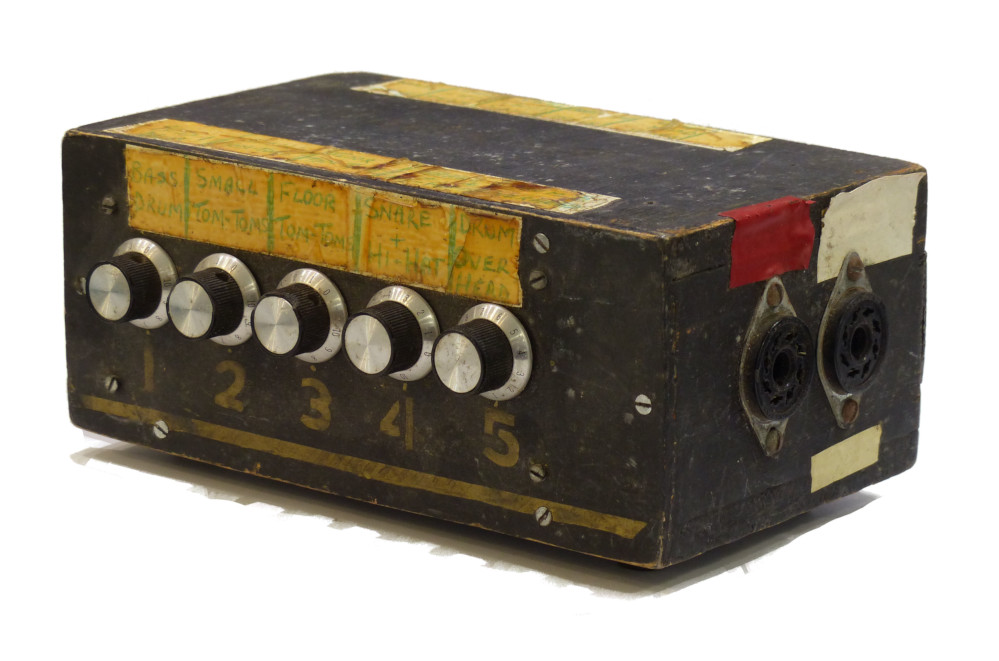
Signal Distribution.
The case provided by Marshall for the mixer was very pretty, finished in leatherette with a plush velvet lining. Rather than damage it we mounted the mixer into a plywood box as a sort of transit case.
The Marshall mixer had many mods. The stage cables came into the mixer on octal valve base connectors and were wired directly to the channel cards in the mixer (it saved having to plug everything in with its own patch cable).
To drive the mono PA I designed an active crossover into the mixer, there were two lines back to the stage one for Low frequencies and one for Mid-high frequencies. You can see the low-high split in the diagram from the mixer lid below.
The mixer's power (op amp style ±15 V) was used for all sorts of things including: the stage mixer, the crossover, signal generators, and a wind noise box that was built into a Strepsils throat sweets tin.
When the band dissolved the mixer had all of its extra bits surgically removed and went back into its pretty box, and I inherited the transit case. My family used it for years on the roofrack of the car to take all of our kitchen stuff when camping. A couple of days ago I remembered that there had been a diagram in the lid of the box describing the connections for the PA components (we weren't too bad at labelling and documenting — odd for lads in a band!). Anyway, I found the lid and sure enough the diagram was still there. Here are the details as written down including a couple of small mistakes:
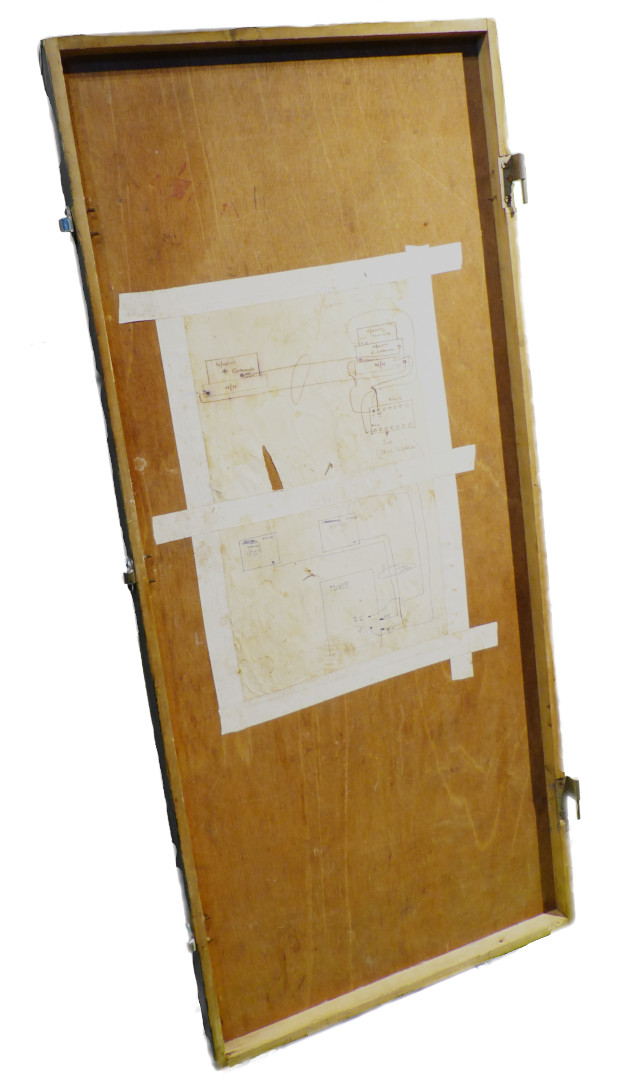
with instructions.
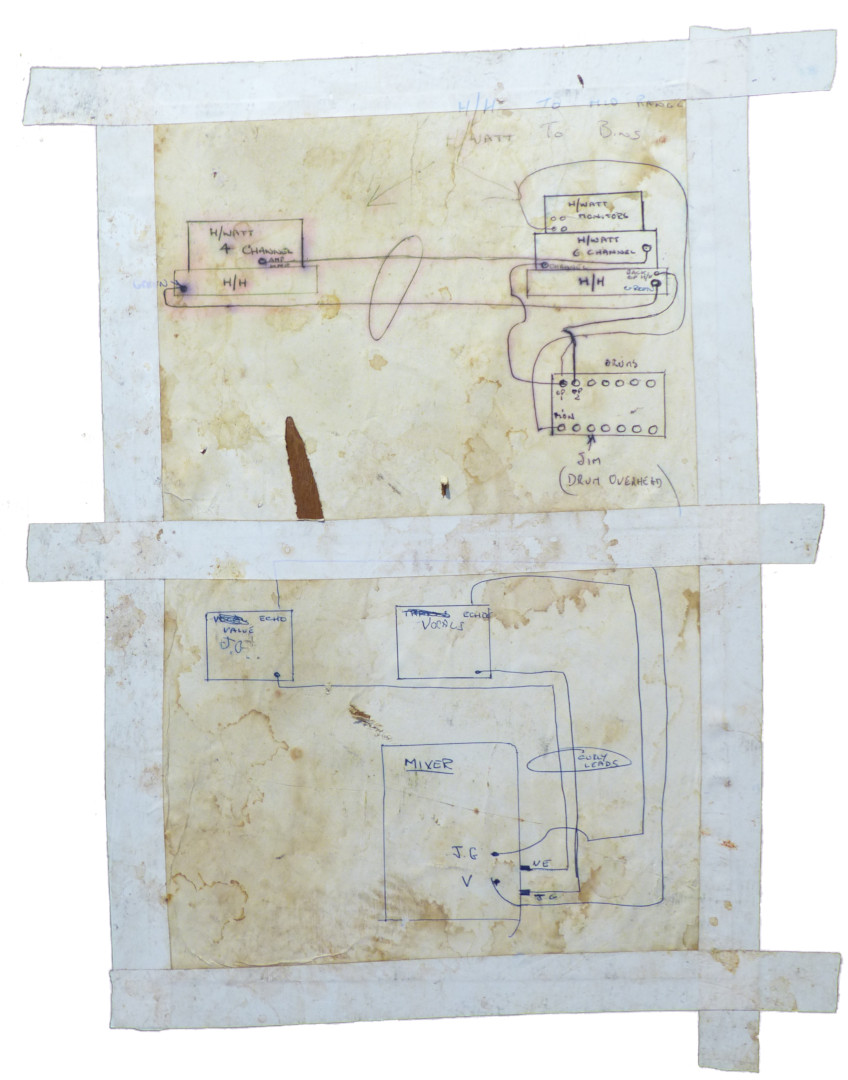
mixer cabling.
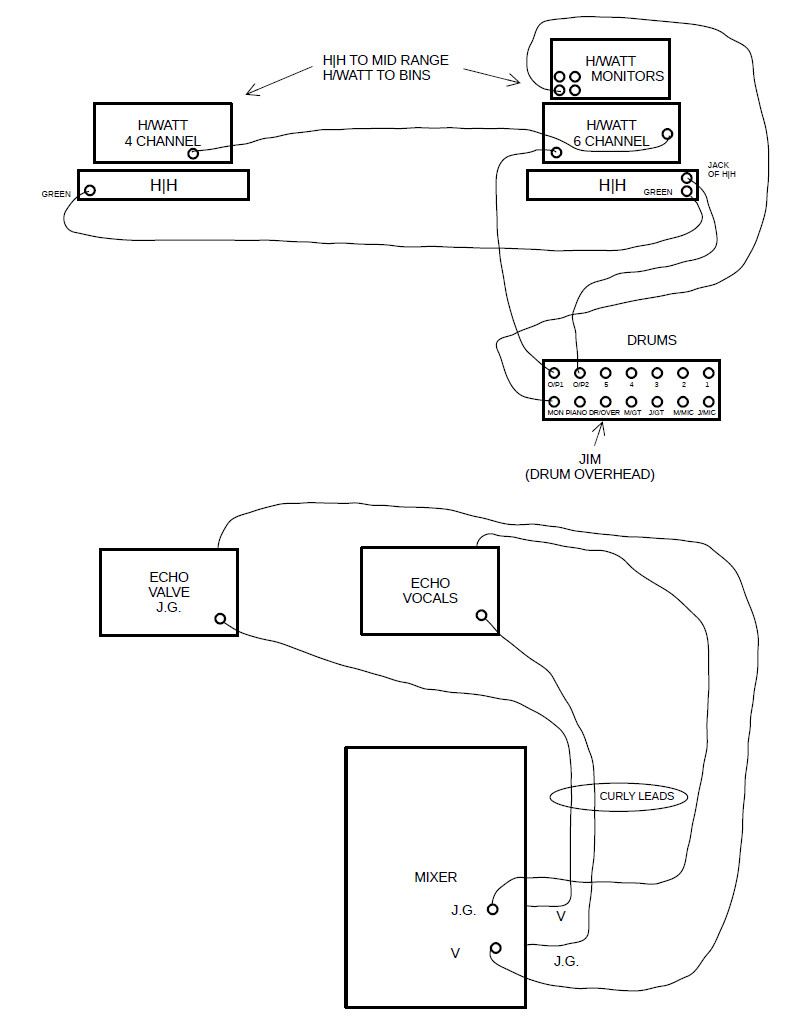
mixer cabling — cleaned up.
WEM Loudspeakers
When I joined the band, like almost everybody we used WEM PA loudspeakers. Typically, in those days, a band would use one 4 × 12 (four 12 inch loudspeakers in a column) at each side of the stage. Cycle used, on each side, two 2 × 15s, one 4 × 12, one 3 × 8, and a high frequency horn.
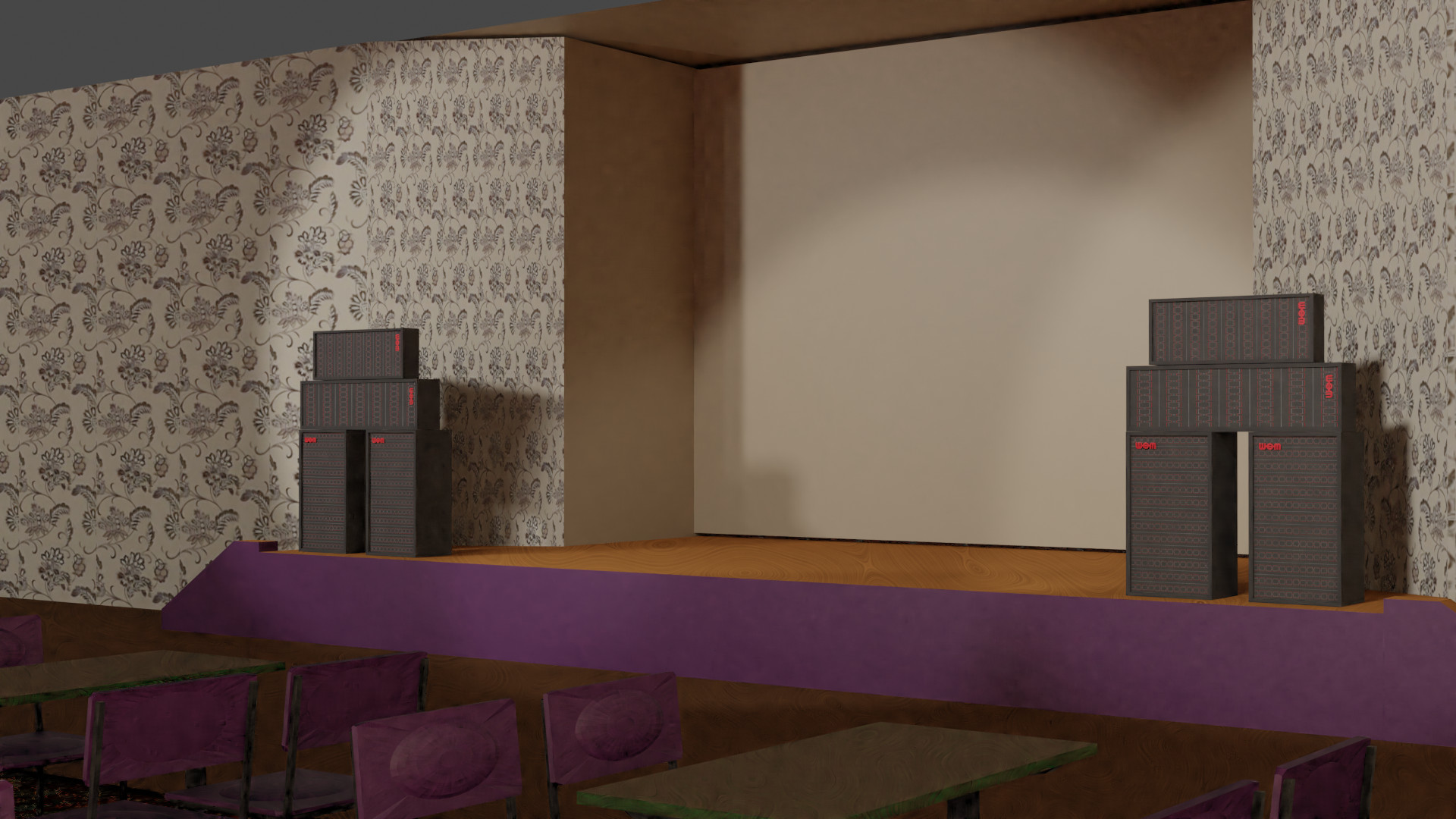
artist's simulation!.
one each side (revolutionary!).
New Bins and Midrange
The final change to the PA was to update the loudspeakers. The mix of WEM cabinets was replaced with new bins for the bass, and dual 12 inch cabs for the mid to high frequencies.
About this time, early '70s new materials were being used for loudspeakers that meant that each loudspeaker was capable of much higher power than previously. A typical 12 inch loudspeaker of the time might handle 20-30 watts. The new loudspeakers with fibreglass coil formers could handle 100 watts.
The new midrange cabinets each used two Fane Crescendo 12 inch units, the Fane Crescendo was rated by the manufacturer at 100 W with a frequency response up to 16 kHz. The Crescendo was very bright for a 12 inch loudspeaker and they did the job brilliantly.
The two new bass bins were modelled on a "Voice of the Theatre" design with 15 inch Gauss loudspeakers in a horn front loaded, bass reflex design. Each was driven by a Hiwatt 100 W amp.
Sadly I don't have any photos of this last PA configuration. It did the job, and was smaller and much easier to set up than the WEM columns.
Copicats
A key component of Cycle's sound was the use of tape echo. It was used for vocals, synth effects and, of course, on John's guitar sound. There were two echo machines, both WEM Copicat models, a valve unit for John's guitar and a transistor model for other uses, vocals, synths, etc. Almost the main task for me during performances was operating the Copicats. Connecting them to the right source at any time and switching them in an out when required with the right settings. We also used extra effects by switching off the motor to get a sort of winding down effect like DJs slowing vinyl nowadays. An example of Copicat effects is on the track "Father of time" from the first (white) album.
John's Sound
John's sound was magic but, from an equipment point of view, very simple — most of the magic came from John and his technique, he was brilliant. When he played vibrato and bent notes he made it look effortless, when he used controlled feedback and sustain he just turned slightly towards his stack and made the guitar sing.
The components of his sound were as follows:
| Item | Model |
| Guitar | Gibson SG shape with Les Paul etching on the nut cover. |
| Amp | Laney 100 W Valve |
| Speakers | Two Laney 4 × 12 cabs |
| Pedals | Custom Sustain, and Wah Wah |
| Microphone | Shure Unidyne III |
| Echo | WEM Copicat valve model |
The guitar was obviously very special, oddly a friend of ours living in a village nearby had one just like it with a serial number one digit different from John's. I don't remember if they ever had a shootout to find which one was best!
If there was a secret weapon it was the sustain pedal. On the outside it looked like a wah wah but inside it had been reconstructed by someone that John knew. With it activated you just showed the guitar to the cabs and it (in John's hands) sang.
The WEM Copicat was also an important part of John's sound and he had one dedicated to his guitar.
The Roadies
The Road Crew was Jim (Jegs) Broughton, who also played some keyboard from time to time, Dave (Stokesie) Stokes, myself, and the rest of the band. There was no demarcation, and everyone helped to set up and break down. We had about a ton and a half of gear that we could easily set up in about twenty minutes, and get back out into the van in ten. The Working Mens' Clubs stopped serving at 10:30 PM, they had 10 minutes drinking-up time, and often closed the doors by 11:00. So, we had to be quick or get locked in.
The reason that we could set up and break down so efficiently was that everything was well organised and labeled. From time to time we had "check and repair" sessions to make sure that everything worked and was in it's place.
The key points were:
- Cables and mike for each band member were in a bag for that player. We used cloth bank cash bags, each one a different denomination/colour for each player.
- There were wooden ammo crates with all of the cables for a given purpose, the stage, the PA, and the mixing desk.
- Each player had his own colour code for cables and mike, for example, all the cables for Mal had green pvc tape at each end.
- All of the PA cables were made to fit the largest venue that we would come across.
There was a map for the location of each piece of equipment — you just placed each item, laid out the cable bundles, connected up, and switched on.
If any item failed to work there was a backup plan to work around the loss. (Admittedly, with the exception of the instruments and Norman). I don't know what we would have done if John's guitar was broke! Mal could have borrowed my bass — on the other hand a Hofner Violin Bass doesn't scream, "Heavy Rock!" like his heavily carved hand made jobbie! It could have been embarassing!!
As for Norman, he was by definition irreplaceable!
